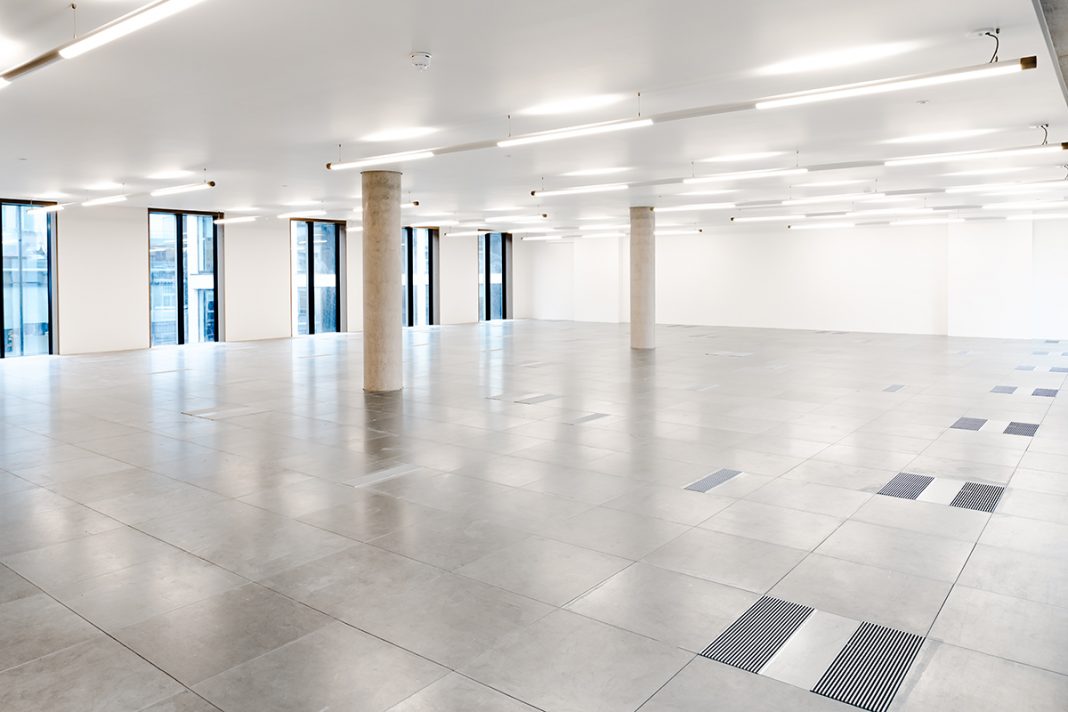Plenum air conditioning systems offer an array of benefits compared with high-level services
“If it is this good, why isn’t it used more often?” Words often iterated by those learning about underfloor air conditioning for the first time. Unfamiliarity, resistance to change or higher capital costs are all reasoned to be barriers to low-level services adoption, despite being accepted by certain leading developers.
Specifiers in the building services market are accustomed to traditional ceiling-based services and will typically put forward a system they know and understand well as to mitigate their own personal risk in the design and specification process. By not considering low-level services, they are potentially restricting the building’s design and future change of use.
Flexibility is key, but what does this mean?
Flexible workspace, flexible offices, flexible working, agile workspace, the list goes on.
These are all terms used arbitrarily in the commercial office marketplace, but often they focus on people and process, HR and lease terms rather than building services functions. At AET, we manufacture the “Flexible Space System”, which is arguably the original underfloor air conditioning system.
Flexible by name and flexible by nature, underfloor equipment is not capable of being bent, nor is it pliable; rather, it is able to be modified and is adaptable to changing use of space, a rare function seen in air conditioning systems – so much so, specifiers are often sceptical when first acquainted with it.
A high-level services strategy is often perceived to be a more “traditional” method of distributing services within office space. However, a services zone dimension in the ceiling space is required to accommodate the ventilation ductwork, terminal units, pipework and associated power supply provision, and if these services are to remain exposed and on view, this would require a heightened level of coordination to provide a tidy aesthetic installation – challenging at the best of times.
How the application of a low-level services strategy can offer a number of benefits when compared to specifying high-level services
By adopting a low-level services strategy, equipment is installed within the plenum beneath the raised floor, which effectively becomes the ventilation zone. This space-saving design permits reduction in slab-to-slab height, which, when calculated across a development, can equate to the creation of an additional floor for the building.
Height savings in new builds can be attributed to underfloor air conditioning, clearly shown at the recently completed 42 Berners Street project, where developers were able to create an additional seventh floor by adopting a low-level services strategy, yet stayed within the imposed planning height constraints.
In refurbishment projects, slab-to-slab heights are often restrictive, and again we can show how installing low-level services can maximise headroom and meet British Council for Offices (BCO) standards for minimum floor-to-ceiling heights.
A classic case study is Tricorn House, Birmingham, where UfAC was specified as an option that would bring cooling to the inner areas of each deep space floor area, while maximising headroom with a restrictive 2.8m slab-to-underside slab height.
Over the phased 12-year refurbishment, the system has proved to be adaptable and flexible for the multi-tenanted building, easily accommodating increasing cooling load requirements through higher density and occupant demand at Cat-B fit-out stage.
A further feature was the addition of units that introduce fresh untreated air at floor level to the down flow units, significantly reducing plant space riser and maintenance requirements.
Height saving and maximising headroom are significant benefits of a low-level services strategy but designers must consider these various strategies in conjunction with occupant thermal comfort, not solely the building’s form and function.
Thermal comfort is achieved when air temperature, humidity and air movement are balanced correctly, but this can also be affected by individual personal factors, such as clothing and metabolic rate. Overhead systems are often criticised for being draughty, with little or no control over air temperature.
Indoor air quality is also compromised as contaminants that can collect at ceiling level are repeatedly circulated back into the breathing zone by the downward flow of air. With underfloor systems, the dilution of contaminants is increased, thus promoting a healthy environment.
Zoned space layouts help to reduce cross contamination, and adding personal control of fan speed and temperature results in a level of comfort cooling that is undeniably superior. It is therefore not surprising that underfloor fan terminals are commonly retrofitted to displacement ventilation systems to boost thermal comfort.
Further cost and energy savings are apparent through the zonal system’s design and modular equipment. By using the void beneath the raised floor as a plenum, enhanced plant and machinery allowances can be granted for the capital outlay, potentially equating to huge cash paybacks.
Underfloor systems are deemed to be sustainable. Employing modular equipment and zoned layouts, each zone can be operated with autonomy, but it is the inherent flexibility of the system that can futureproof a building for the specifier.
A British Council of Offices (BCO) report published in 2002 – Sustainable Buildings are Better Business, Can we Deliver Them Together? – compares various air conditioning options over a 25-year period and suggests that the combined capital costs for the developer (CAT-A) and tenant (CAT-B) is the lowest for the underfloor system, and it is considerably cheaper when considering other factors such as churn, energy, replacement and maintenance.
Flexibility is therefore key and the ability of low-level services to adapt to changing use of space makes underfloor systems and a low-level services strategy comparably more cost-effective and sustainable.
Abigail Wood
Marketing manager
AET Flexible Space
Tel: 01342 310400
Twitter: @AET_FSS
*Please note: this is a commercial profile.














